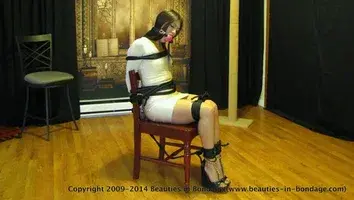Have you ever wondered why there’s such a growing interest in the idea of beauties in bondage? Maybe you’ve come across it in conversations, media, or maybe you’re curious about it yourself. It’s a topic that sparks curiosity, controversy, and plenty of intrigue. But here’s the thing: there’s more to this than meets the eye. So, let’s dive into what’s behind this fascination, why it’s so prevalent, and how it goes beyond what most people assume.
What Does “Beauties in Bondage” Really Mean?
The term “beauties in bondage” often brings up images that many might find daring or even taboo. But if we take a step back, it’s less about shock value and more about exploring the relationship between freedom, trust, and self-expression. Essentially, it’s about embracing a form of vulnerability—one that’s often viewed as empowering by those who choose it.
This exploration isn’t just a surface-level trend. It’s something that reaches into history, psychology, and even art. People have long been fascinated with the push and pull of control and release, particularly when beauty and aesthetics are involved. Let’s unpack this further.
Why Are So Many People Drawn to the Concept?
So, what’s driving this fascination with beauties in bondage? Why do people feel drawn to an idea that might seem contradictory on the surface? Let’s break down some common reasons:
- Psychological Appeal: For some, it’s about the thrill of vulnerability—letting go of control in a world where we’re always trying to keep it. The concept provides a controlled environment to explore these feelings safely.
- Artistic Expression: Artists, photographers, and filmmakers often turn to bondage themes for the striking visuals and raw emotions they evoke. It’s not always about romance or sensuality; it can be a powerful way to represent strength, struggle, or simply beauty in restraint.
- Building Trust: Believe it or not, this concept hinges on trust. In many cases, people view these acts as deeply personal and trust-driven. It’s often a shared experience, one where communication and boundaries are key.
- Empowerment and Identity: Many people find a sense of empowerment in stepping outside of societal norms. This exploration can offer a new way of understanding oneself, which can be incredibly freeing—even within the restraints.
- Cultural and Historical Influence: The fascination isn’t new. Different forms of bondage-inspired art and practices have existed across cultures and centuries. From Japanese shibari art to more modern adaptations, the concept has been redefined and reinterpreted.
Busting Myths Around “Beauties in Bondage”
There’s no shortage of myths surrounding the idea of bondage, especially when beauty is involved. Let’s set the record straight on a few common misconceptions:
- It’s All About Sensuality: Not necessarily. While some people explore it for romantic reasons, others are interested purely in the artistic or empowering aspects. For some, it’s about self-expression or breaking free from societal expectations.
- It’s Dangerous and Irresponsible: This is a big one. When done responsibly, with consent and boundaries, bondage can be a safe practice. The emphasis is always on communication, safety, and respect.
- It’s Only for a Niche Audience: Surprisingly, the concept appeals to a broader audience than you might think. Mainstream media, art exhibitions, and fashion have all dipped into bondage themes, proving its widespread allure.
How Does Bondage Intersect with Beauty?
What does beauty have to do with bondage? It’s a fair question. Beauty, in this context, can mean a lot of things—confidence, aesthetics, and even self-discovery. Here’s how they intersect:
- Strength in Vulnerability: There’s a unique type of beauty that comes from showing vulnerability. For many, experiencing or witnessing bondage in a safe setting offers a window into a side of themselves they don’t usually see.
- Aesthetic Appeal: Artists have long used the imagery of restraint as a way to create contrast and tension, both visually and emotionally. It’s the juxtaposition of control and chaos, beauty and restraint.
- Empowerment through Restriction: Odd as it may sound, feeling restricted can help people find a new sense of self-control. It’s about finding freedom within boundaries, which is an incredibly personal journey for many.
- Creating a Story: Beauty often tells a story, and bondage adds layers to it. Every piece of art, every photo, every experience tells a different tale. It’s a way to capture raw emotion and depth in a way few other subjects can.
Taking a Deeper Dive: Exploring Bondage as Art
Art has always flirted with boundary-pushing themes. When it comes to beauties in bondage, artists find a way to challenge traditional norms and bring up questions about beauty, control, and self-image. Think about the rich, contrasting colors in paintings or the delicate yet powerful compositions in photography.
Here’s how bondage has inspired artists across different mediums:
- Film: Directors use bondage to build suspense, intensity, or even illustrate character development. It adds a visual layer of complexity to scenes that would otherwise lack depth.
- Photography: Many photographers explore beauty through restraint, capturing the push and pull between elegance and strength. The contrast alone can make a viewer pause and think.
- Performance Art: Bondage has roots in performance art, where artists use their own bodies to make statements on control, consent, and freedom.
The Role of Consent and Communication
Here’s a crucial point: everything in this realm hinges on consent and clear communication. Without it, there’s no trust—and without trust, there’s no true beauty in the act. For those exploring bondage, these elements are non-negotiable. They’re what make the experience feel safe, respected, and even liberating.
Finding Empowerment in Bondage
Many people find empowerment in embracing their vulnerability. It’s a way to push boundaries in a controlled, respectful environment. It’s not about giving up control—it’s about choosing when and how to let go. For some, this is where real beauty lies: in the choice, the trust, and the experience of surrender.
FAQs about Beauties in Bondage
Q: Is bondage only for a niche audience?
A: No. While some view it as a niche interest, it actually appeals to a wide variety of people. Whether through art, film, or self-exploration, the concept reaches a broad audience.
Q: Is it safe?
A: When practiced responsibly, yes. Safety in bondage relies on consent, communication, and respect. Setting clear boundaries is essential.
Q: Is it about sensuality?
A: Not exclusively. Many people explore bondage for artistic, empowering, or personal reasons. It’s often about beauty, trust, and self-discovery.
Q: How does bondage relate to self-expression?
A: For some, bondage is a form of self-expression that allows them to step outside societal norms, explore vulnerability, and find a new sense of empowerment.
Final Thoughts on Beauties in Bondage
The concept of “beauties in bondage” goes deeper than surface-level interpretations. It’s about exploring what it means to feel vulnerable yet empowered, restrained yet free. This exploration of trust, identity, and self-expression taps into universal human experiences, giving people a new lens through which to view beauty and control.
In a world where control often feels out of reach, finding a way to embrace vulnerability can be a form of liberation. For many, that’s where the true beauty lies—in choosing to let go, even if only for a moment.
At the end of the day, beauties in bondage isn’t about stereotypes or assumptions. It’s about the stories, emotions, and powerful moments that come from stepping beyond the norm, pushing boundaries, and embracing the complex relationship between freedom and restraint.
Read More: SkinCareSensation

